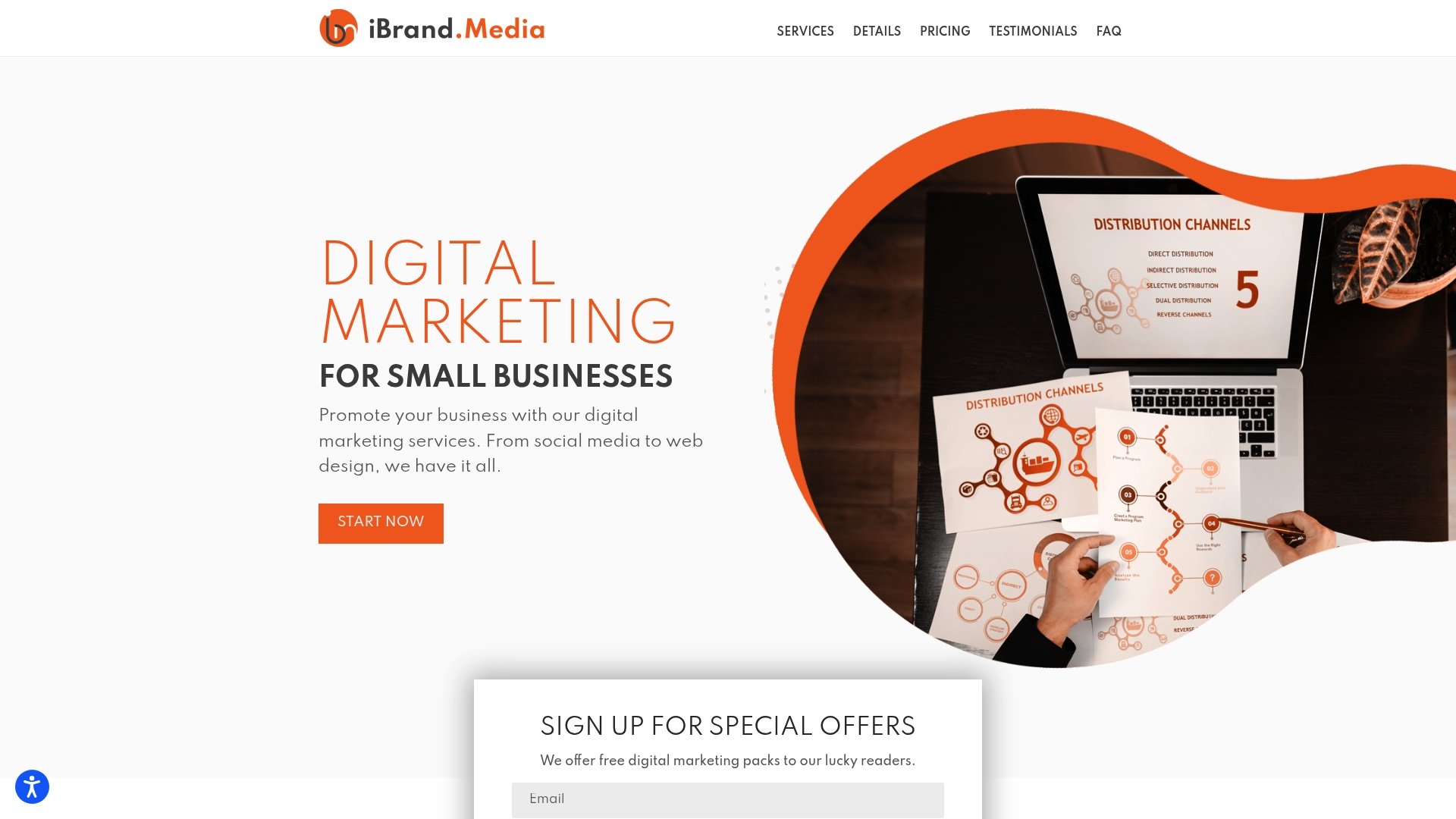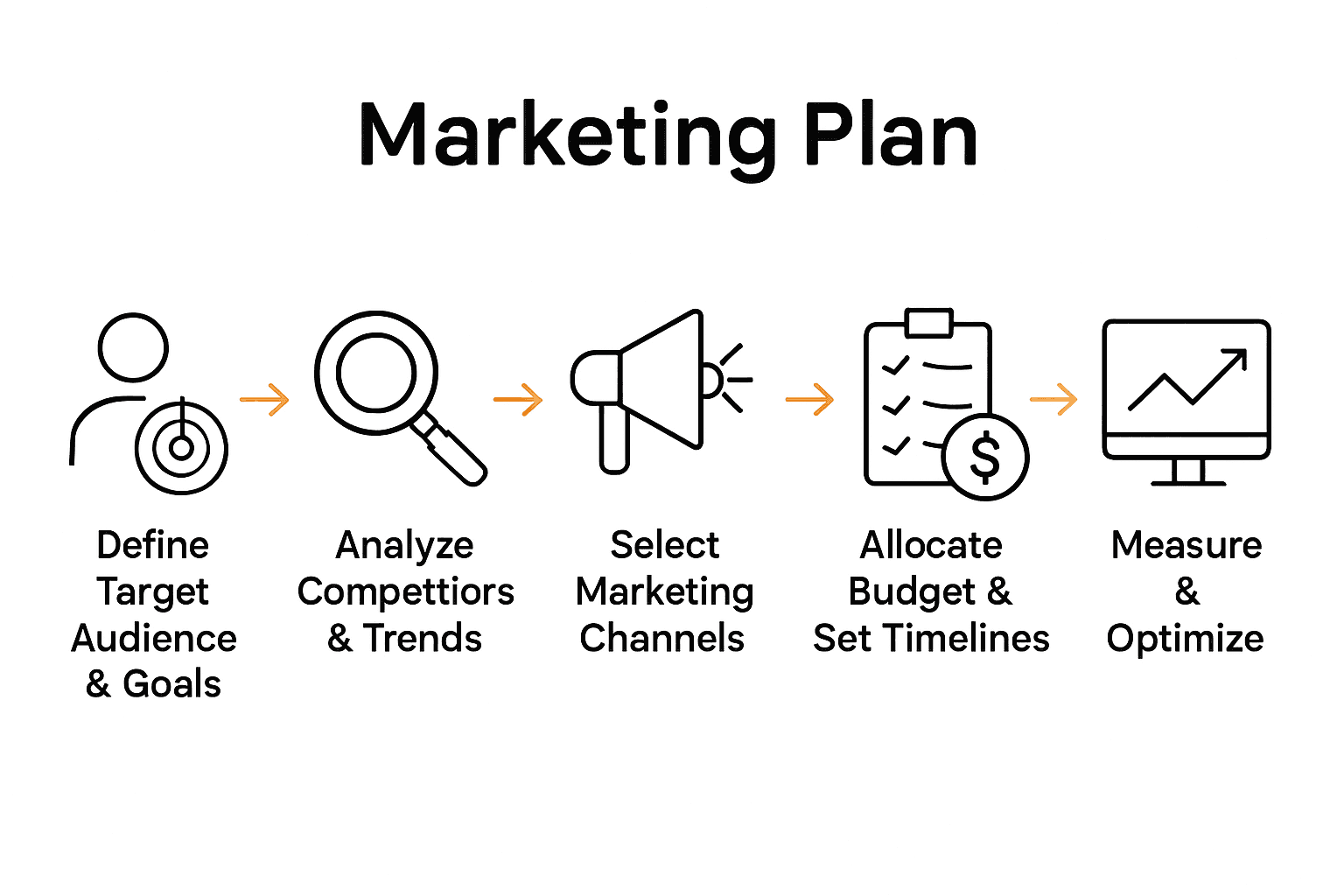Over 80 percent of small businesses say targeting the right audience fuels their growth more than any other factor. With so many options and limited resources, finding what truly works can make the difference between struggling and thriving. Here you’ll discover a clear plan to help your business focus your efforts, outsmart competitors, and make every marketing dollar count.
Table of Contents
- Step 1: Define Target Audience And Goals
- Step 2: Analyze Competitors And Market Trends
- Step 3: Select Effective Marketing Channels
- Step 4: Develop Messaging And Promotional Tactics
- Step 5: Allocate Budget And Set Timelines
- Step 6: Measure Results And Optimize Strategy
Quick Summary
| Key Point | Explanation |
|---|---|
| 1. Define target audience carefully | Analyze demographics, psychographics, and challenges to create effective marketing strategies. |
| 2. Conduct thorough competitor analysis | Identify competitors and market trends to uncover opportunities and position your business advantageously. |
| 3. Choose focused marketing channels | Limit your platforms to 2-3 where your audience is most active for better engagement and resource allocation. |
| 4. Create consistent messaging | Develop a clear narrative that articulates your unique value and resonates emotionally with your audience. |
| 5. Measure and optimize regularly | Track key performance indicators and adjust strategies based on data for ongoing marketing effectiveness. |
Step 1: Define target audience and goals
Defining your target audience and marketing goals represents the strategic foundation of your small business marketing plan. This crucial step helps you focus your limited resources precisely where they will generate the most impact.
According to the University of Houston Small Business Development Center, understanding your audience requires deep analysis of their characteristics. Go beyond basic demographics and explore their values, lifestyle, hobbies, buying habits, and specific challenges. This comprehensive approach allows you to craft marketing strategies that genuinely resonate with potential customers.
To effectively define your target audience, start by creating detailed customer personas. Ask yourself key questions: Who needs my product or service? What problems am I solving? What are their age ranges, income levels, professional backgrounds, and personal interests? Map out these specifics to develop a clear picture of your ideal customer.
Research from Wikipedia emphasizes considering demographics, psychographics, and consumer lifestyles to maximize your marketing effectiveness. This means looking not just at who your customers are, but understanding their motivations, pain points, and decision making processes.
Pro tip: Don’t try to appeal to everyone. A focused marketing approach targeting a specific audience will always outperform generic strategies. Be precise and intentional about who you want to reach.
Once you have a clear audience profile, translate this understanding into concrete marketing goals. These should be specific, measurable objectives that align with your overall business strategy such as increasing website traffic, generating leads, or boosting sales by a specific percentage within a set timeframe.
Step 2: Analyze competitors and market trends
Analyzing competitors and understanding market trends are essential steps in developing a strategic marketing plan for your small business. This process helps you identify opportunities, potential challenges, and unique ways to position your offerings.

According to the U.S. Chamber of Commerce, conducting a comprehensive competitive analysis involves evaluating multiple dimensions of your business landscape. Start by identifying direct and indirect competitors in your market. Create a detailed spreadsheet tracking their products, pricing strategies, marketing messages, and customer experiences.
The University of British Columbia’s Small Business Accelerator recommends developing a systematic approach to competitive research. List out key competitors and gather information about their sales volumes, market share, pricing structures, and marketing tactics. This data will help you understand your current market position and potential growth opportunities.
To perform an effective market trend analysis, leverage online tools, industry reports, and social media insights. Look for emerging customer preferences, technological innovations, and shifts in consumer behavior that could impact your business. Pay attention to seasonal trends, economic indicators, and changes in your specific industry.
Pro tip: Conduct a SWOT analysis to map out your business’s strengths, weaknesses, opportunities, and threats. This strategic framework will help you develop marketing strategies that capitalize on your unique advantages while mitigating potential risks.
Remember that competitive analysis is not a one time task. Market dynamics change rapidly, so plan to review and update your research quarterly to stay ahead of emerging trends and shifts in customer demands.
Step 3: Select effective marketing channels
Selecting the right marketing channels is critical for maximizing your small business’s reach and connecting with potential customers. Your goal is to choose platforms that align closely with your target audience and business objectives.
According to Wikipedia’s entry on Audience Segmentation, businesses can strategically divide potential customers into subgroups based on demographics, communication behaviors, and media usage. This approach allows you to pinpoint the most effective channels for reaching specific customer segments.
Start by mapping your target audience’s preferred communication platforms. Consider factors like age, professional background, online behavior, and content consumption habits. For younger audiences, digital channels like Instagram and TikTok might be most effective. Professional services might find more traction on LinkedIn, while local businesses could benefit from Facebook and Google My Business.
Wikipedia’s Microsegment research suggests breaking down your audience into increasingly specific groups to personalize your marketing approach. This means going beyond broad categories and understanding nuanced customer preferences.
Pro tip: Don’t spread yourself too thin. Select 2-3 primary marketing channels where your target audience is most active and concentrate your resources there. Quality and consistency matter more than being everywhere at once.
Remember that marketing channels are not static. Regularly review your channel performance, track engagement metrics, and be prepared to adjust your strategy as your business and audience evolve.
Step 4: Develop messaging and promotional tactics
Developing compelling messaging and strategic promotional tactics is crucial for small businesses to stand out in a competitive marketplace and connect meaningfully with potential customers. Your goal is to create a clear, consistent narrative that resonates with your target audience.
According to Wikipedia’s Business Plan article, your messaging should clearly describe the nature of your business and outline strategies for achieving your goals. This means crafting communication that not only explains what you do but also highlights the unique value you provide to customers.
Start by defining your core brand message. What problem do you solve? What makes your business different from competitors? Develop a concise value proposition that speaks directly to your target audience’s needs and pain points. This message should be consistent across all marketing channels from social media to email communications.
Wikipedia’s entry on Competitive Intelligence emphasizes the importance of systematically analyzing your market to develop differentiated messaging. Research your competitors to understand their communication strategies and find unique angles that set your business apart.
Pro tip: Focus on benefits rather than features. Customers care more about how your product or service improves their life than technical specifications. Tell a story that connects emotionally and demonstrates real world value.
Consider creating a messaging matrix that outlines different communication approaches for various customer segments and marketing channels. This will help you maintain consistency while allowing flexibility to tailor your message to specific audiences.
Step 5: Allocate budget and set timelines
Allocating your marketing budget and establishing realistic timelines are critical steps in transforming your marketing strategy from a theoretical plan into actionable reality. This process requires careful consideration of your business resources and strategic goals.
According to the OpenStax Entrepreneurship guide, understanding your competitive landscape can significantly inform budget allocation decisions. Start by analyzing the marketing spend of similar businesses in your industry and identifying cost effective channels that provide the best return on investment.
Break down your total marketing budget into specific categories such as digital advertising, content creation, social media marketing, and promotional materials. A general rule of thumb for small businesses is to allocate between 7 to 12 percent of total revenue toward marketing efforts. However, this can vary depending on your industry and growth stage.
The U.S. Chamber of Commerce recommends conducting a SWOT analysis to help set realistic timelines. Assess your business strengths and potential constraints to create a marketing timeline that is both ambitious and achievable.
Pro tip: Build flexibility into your budget and timeline. Set aside 10 to 15 percent of your marketing budget as a contingency fund for unexpected opportunities or necessary pivots.
Establish quarterly review points to evaluate your marketing performance, adjusting your budget and timeline based on actual results and emerging market trends. This adaptive approach ensures your marketing plan remains responsive and effective.
Step 6: Measure results and optimize strategy
Measuring marketing results and strategically optimizing your approach is the final critical step in ensuring your small business marketing plan delivers meaningful growth and success. This process transforms your marketing from a guessing game into a precise, data-driven strategy.
Research from Big Data Analytics-Enabled Dynamic Capabilities emphasizes how data-driven insights can dramatically enhance marketing performance. Start by identifying key performance indicators (KPIs) that directly align with your business goals. These might include website traffic, conversion rates, customer acquisition cost, social media engagement, and total revenue generated from marketing efforts.
Implement robust tracking tools to monitor these metrics consistently. Google Analytics, social media insights, and email marketing platforms offer comprehensive data visualization that can help you understand which strategies are working and which need refinement. Analyze these metrics monthly to spot trends, successes, and potential areas for improvement.
The Machine Learning Framework study highlights the importance of competitive intelligence in optimizing marketing strategies. Regularly benchmark your performance against industry standards and direct competitors to identify opportunities for differentiation and improvement.
Pro tip: Create a simple dashboard that consolidates your most important metrics. This visual representation makes it easier to quickly assess your marketing performance and make informed decisions.
Remember that optimization is an ongoing process. Be prepared to pivot your strategy based on data insights, test new approaches, and continuously refine your marketing plan to stay competitive and responsive to market changes.
Elevate Your Small Business Marketing Plan with Expert Guidance
Creating a marketing plan that drives real results can feel overwhelming when you face challenges like defining your target audience or choosing the right marketing channels. This article highlights key steps such as competitive analysis, messaging development, and budget allocation that every small business owner must master to succeed. If you find yourself needing clear direction and actionable strategies, you are not alone.
Explore how proven digital marketing solutions can simplify this complex process. At Ibrandmedia, we specialize in crafting tailored marketing plans that address your unique goals and pain points. Whether you want to improve local outreach, boost online visibility, or track your campaign performance in real time, our services put you on the fast track to growth. Dive into our insightful resources like Uncategorized | Ibrandmedia to get started with foundational marketing concepts.

Take control of your marketing success now. Visit ibrand.media to discover affordable, personalized strategies designed for small businesses ready to expand. Don’t delay, your roadmap to measurable growth is just a click away. Reach out today and transform your marketing plan into a powerful business asset.
Frequently Asked Questions
How do I define my target audience for a marketing plan?
To define your target audience, create detailed customer personas that include demographics, values, and specific challenges. Start by asking questions about who needs your product and what problems you solve for them.
What are the key steps to analyze competitors for my marketing plan?
To analyze competitors, identify both direct and indirect competitors, then evaluate their products, pricing, and marketing strategies. Create a spreadsheet that tracks this information to understand their market position relative to your business.
How can I choose the right marketing channels for my business?
Select marketing channels that align with where your target audience is active. Map out your audience’s preferred platforms and prioritize 2-3 channels to focus your marketing efforts effectively.
What should I include in my marketing messaging?
Your marketing messaging should highlight your core value proposition and the unique benefits your product or service provides. Craft a clear narrative that focuses on how you solve customer problems and maintain consistency across all channels.
How do I allocate a budget for my marketing plan?
Allocate your marketing budget by breaking it down into categories like digital advertising and content creation. A good starting point is to set aside 7 to 12 percent of your total revenue for marketing efforts, adjusting based on your industry needs.
What metrics should I track to measure my marketing results?
Track key performance indicators (KPIs) such as website traffic, conversion rates, and social media engagement to measure your marketing results.
 Regularly analyze these metrics to identify trends and make necessary strategy adjustments.
Regularly analyze these metrics to identify trends and make necessary strategy adjustments.
Recommended
- How to Set Marketing Goals for Small Business Success 2025 | Ibrandmedia
- Creating a Marketing Plan in 2025: A Guide for Local Businesses | Ibrandmedia
- Developing a Digital Marketing Plan: A 2025 Guide for Small Businesses | Ibrandmedia
- Developing a Digital Marketing Plan: A 2025 Guide for Small Businesses | Ibrandmedia
- How to Create a Marketing Plan for Business Success
- How to Create a Marketing Plan – Resen Digital

Recent Comments